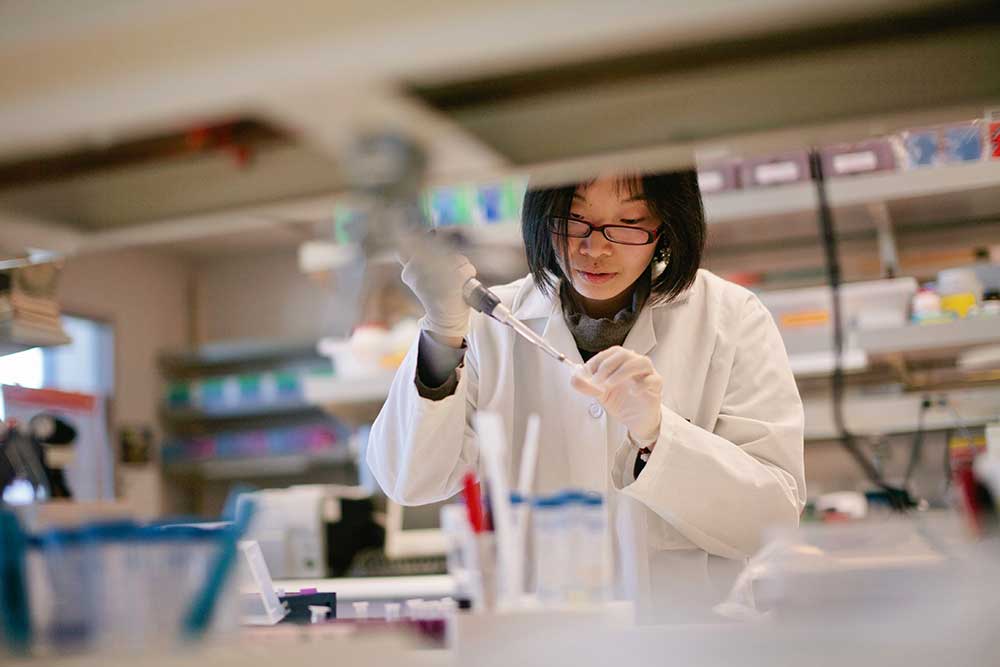Disclaimer: The information on our website is provided for general information purposes only. We make no representations or warranties of any kind, express or implied, about the completeness, accuracy, reliability, suitability or availability with respect to the website or the information contained on our website for any purpose. Any reliance on such information is therefore strictly at your own risk and we are not liable for any damages or losses arising out of or resulting from your reliance on any information contained on our website.
A biomedical engineer enhances the quality and effectiveness of patient care by designing and analyzing solutions to problems in medicine and biology. You must have knowledge in the evaluation, design, and development of biological and health systems or products.
Watch a video to learn what a biomedical engineer does:
How to Become a Biomedical Engineer
An employer usually looks for a bachelor’s degree in biomedical engineering. It is also possible to get a bachelor’s degree in another field of engineering and then you can earn a graduate degree in bioengineering. Coursework for both undergraduate and graduate degrees would include laboratory-based courses in addition to classroom-based courses. Subjects such as physiology, fluid/solid mechanics, computer programming, circuit design, biomaterials and other biological sciences.
Job Description of a Biomedical Engineer

A biomedical engineer conducts research on engineering aspects of biological systems such as in humans and animals. They do this by working in teams with scientists, healthcare workers, or other engineers. They use principles of bio-behavioral and engineering sciences to develop and design clinical instrumentation and medical diagnostics, procedures, and equipment. A biomedical engineer for example would research new materials that could be used in artificially implanted organs. They acquire data to control life processes or for measuring. He or she may assist medical science by designing computer software or hardware and adapting it for medical science.
Biomedical engineers will use signal processing techniques, interpret bioelectric data, or deliver and design technology. You may also use (MRI) scanners, pressure indicators, and electronics among other tools and technology. A biomedical engineer should have knowledge in chemistry, physics, mathematics, biology, and many other areas of relevant education in this career field. They should be able to think creatively, stay up-to-date with current technology and solve problems among other skills. The biomedical engineers work in hospitals, universities, research facilities, government regulatory agencies, medical and educational institutions or even in manufacturing.
Biomedical Engineer Job Posting
Let’s look at a job description posted by the U.S. Army Medical Command. This job announcement is looking for a person to perform the following responsibilities:
- Participate as a team member in conducting research studies aimed at furthering the rehabilitation of individuals with functional and anatomic limb loss in the (EACE) Research and Surveillance Division.
- Apply diversified engineering practices, including medical and biological principles to complex multi-disciplinary research projects.
- Conduct studies within the broad areas of physical rehabilitation, exercise physiology, and gait assessment.
- Able to formulate and present findings, briefings, project papers, status reports, and correspondence to foster understanding and acceptance of findings and recommendations.
- Utilize work conclusions in the form of new or modified equipment, research, systems analyses, computer code or simulations.
This position was posted to run 01/10/2019 until 01/22/2019 with a salary range of $61,218 to $79,586 per year on USAjobs.gov (link opens in a new tab). USAjobs.gov is an official website of the United States government and part of the U.S. Office of Personnel Management.
Free Teacher and Student Resources
Brown University offers a free Introduction to Engineering and Design course on EdX.org (link opens in a new tab) with the option to pay a small fee receive a verified certificate upon completion of the course.
By taking this course, you’ll learn:
- Foundational knowledge of the primary fields of engineering, including Biomedical, Chemical, Civil, Electrical, Materials, and Mechanical Engineering.
- Techniques and applications of the engineering design process.
- How to conceptualize, design, build, and assess a prototype that solves an engineering problem.
Biomedical Engineer Video Transcript
Biomedical Engineers develop technologies that help improve the quality of people’s health, or their ability to manage disabilities and may even save their lives. The field combines biology and medicine with engineering and mechanics, a combination that leads to amazing results. Imaging systems that allow doctors to see inside a patient’s organs, artificial limbs, organs, and joints. Lasers for surgery. Devices that automate insulin injections. Computer simulations to test new drug therapies. Biomedical engineers designed all of these, and also keep them running. Making sure their designs operate safely and correctly is a large part of their job. These engineers can expect to spend many hours, even years, on a specific project in a cycle of researching, developing, testing, and trying again.
Among the qualities needed are patience, problem-solving, and the ability to handle complex calculations. Most jobs are found in research laboratories, hospitals, and manufacturing. To enter the field, you will need a bachelor’s degree in biomedical engineering or bioengineering. Some people enter the field with a bachelor’s degree in another field of engineering coupled with biological science electives, or they earn a graduate degree in biomedical engineering. Whatever their path to the profession, biomedical engineers share a passion for making a patient’s life longer and easier.
Article Citations
Bureau of Labor Statistics, U.S. Department of Labor, Occupational Outlook Handbook, Biomedical Engineers.
National Center for O*NET Development. 17-2031.00. O*NET OnLine.
The career video is Public Domain from the U. S. Department of Labor, Employment and Training Administration.

